Inside The Barista Class
by Molly Osberg
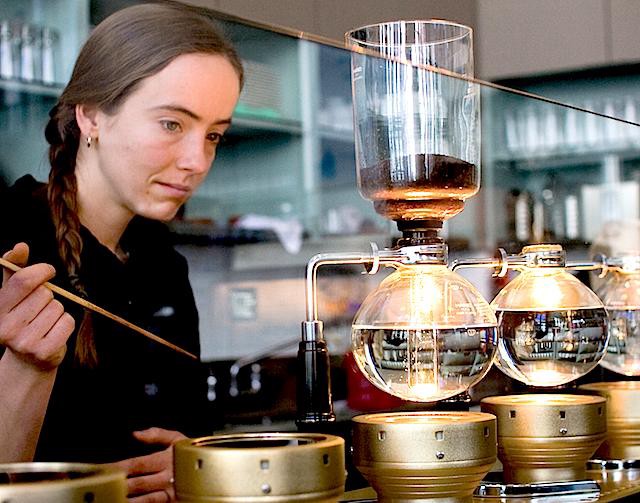
One of the most obscene things I learned as a barista was how eager people are to be liked. NYU sophomores, the ones with Jansport backpacks in full makeup at 9 a.m., stuttered their orders and shyly complimented me on my nose ring. I semi-patiently listened to innumerable Wikipedia-style monologues about the music I was playing from men in their twenties trying to render their business attire invisible with cultural know-how. I was given zines, mixtape-party fliers, home-recorded chillwave demos.
I said things like “How’s the app going?” and “Welcome to the neighborhood.” I answered questions for new Greenpoint residents — of which there were more each year — about the best place to grab wine and tapas, get a shave and drink a beer at the same time. How myself and my co-workers became to be known as experts in such matters was largely beyond me, particularly since many of us shortly couldn’t afford to live in the neighborhood in which we served. More than anything else, though, I was asked what else I did.
“Oh you know,” the t-shirt designer or gallery assistant with blunt bangs or unpaid Harper’s intern would say on their way into the office. “When you aren’t making coffee.”
As the years went by my desire to answer the question honestly waned somewhat, but yes, I did know, and yes, I did things other than make coffee. Some of it was just hustle: there were never quite enough hours to go around, so I transcribed for various friends writing books or dissertations; I worked as an artist’s assistant for a man I became convinced had hired me at an exorbitant rate simply because it made him feel legitimate. The majority of the hours I passed in his studio were spent watching impenetrable video art he’d made five years ago and helping him rearrange the massive pink sectional couch he ostensibly used to host potential buyers, though I never saw a single one. Actually, I had hoped to be a writer when I grew up, but the claim had a little less utility at 24 than it did at 17.
I was 17 when I got my first job, at the Starbucks in my hometown, a suburb about an hour south of Boston. I was trained in the store’s break room through a series of videos. The position’s first directive — conveyed by softly lit panoramas of women chatting over steaming lattes, men in tailored suits smiling gently in the direction of the espresso machine — was to maintain the brand’s identity as a “third place.” The term, as appropriated by Starbucks, was actually originally coined by the sociologist Ray Oldenburg to describe a particular kind of community space, one that facilitated civically minded social interaction. The “first place” is the home and the “second place” is the office, in Oldenburg’s conception, and the idea fit Starbucks’ self-styled business of “conversation and a sense of community” so well that the idea of the third place became their very foundation.
At that age, becoming a barista — as opposed to a waitress, or the girl serving popcorn at the multiplex — seemed like a good idea. In my budding process of cultural affiliation, I’d recognized the coffee shop as my spiritual home from an early age. This was 2006. Like I said, I was suburban. Something about a coffee shop felt intellectual.
There were only two coffee shops in my town, and they didn’t so much compete as complement each other, poised as they were on opposite sides of the economic spectrum. If you weren’t grabbing a large ice coffee, “extra-extra,” (that’s extra cream, extra sugar) from the Dunkin’ Donuts down the street, you were exercising your right to, in the words of Tom Hanks’ character in the immortal You Got Mail, “get not just a cup of coffee but an absolutely defining sense of self. Tall. Decaf. Cappuccino.”
Though the appeal of such choice — and the corresponding price of such decision-making power — comes as no surprise to anyone, I will say that at least twice I gave empty Starbucks cups to high school girls so they could disguise their Mr. Coffee drip in 8 a.m. homeroom.
But actually working at Starbucks wasn’t cool by any stretch of the imagination. It was my first and only corporate job, with its corresponding dress code (khakis, collared shirts, no tattoos) and business practices standardized to a point well past common sense (the temperature, I was told, was controlled remotely, from an office at HQ in the Midwest).
I worked with a number of rosy-cheeked middle-aged women who could quote the company’s binders of promotional materials verbatim. They anticipated Pumpkin Spice Latte season with a terrifying, giddy excitement. One had a “How to Make a Mocha” poster hung in her home, above her living room couch. On the weekends, they got together with their boyfriends — many of whom worked at a Starbucks across town — and made cocktails out of Starbucks-branded coffee liqueur. The motivational posters and the mandatory lunch breaks and the incremental raises every six months or so, practices ripped straight from a corporate (albeit paper-pushing) culture increasingly on the downswing, created an effusive sense of brand identification among its employees I hadn’t imagined before and haven’t seen since.
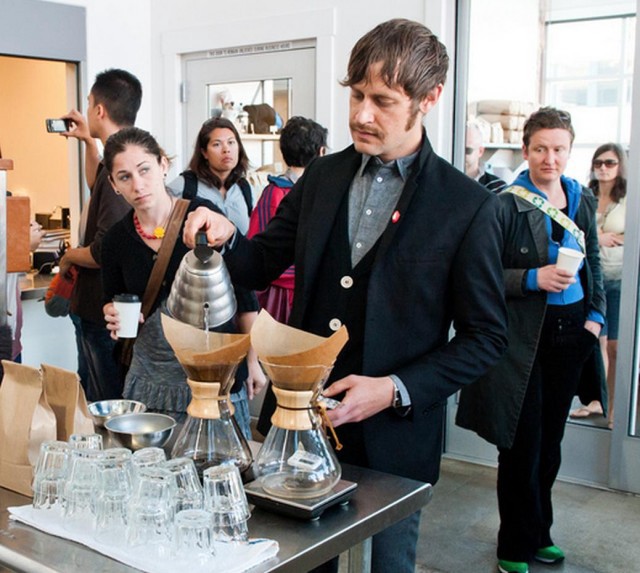
I transferred stores twice, and though I wouldn’t recognize it until later, there was already something uniquely banal about my interactions with the customers at Starbucks. The robotic and infinitely scaleable details, our uniforms and employee numbers, the pre-calibrated automatic espresso machine, all contributed to a general sense of interchangeability. I had exhausting customers, but their demanding nature didn’t feel personal. I had no doubt the pudgy businessman would have told any woman where to put that whipped cream, or that the undergraduate with the fancy handbag, detailing last night’s party to a friend on the phone, was the kind of girl who would’ve shouted down any one of her servers for ostensibly placing a half-pump more white mocha in her beverage. If a customer was particularly bad we exercised one of the only powers we possessed and “decafed” them. To covertly rob a caffeine-addicted asshole of their morning jolt was truly one of the sweetest pleasures of baristahood, and one that my subsequent professions haven’t come close to replicating.
A few hours before close, a younger shift leader might travel the few blocks down Thayer Street to the liquor store. We’d drink Vodka and Red Bull out of our green-and-white venti cups and snigger behind the hulking safety of that massive, push-button espresso machine. As long as we didn’t get so drunk that we slurred the lines we’d been given — “Next guest please; Welcome to Starbucks, how may I help you?” — we were still doing our jobs.
After about a year and a half, I hung up my green apron; I was glad to leave when I did. I tried college briefly, then returned to Boston and began working at a cafe in Somerville. It was a dusty, comfortable coffee shop, with dog treats under the counter, the kind of place where you made ice coffee by pouring coffee over ice. It had been opened in 2004 by two friends who’d met while working at a chain bakery; almost all the employees attended one of the nearby colleges. The shop held a corner in a small, unassuming neighborhood, and I lived down the street, in a row house I shared (or more precisely, was crashing at) with friends, flanked on either side by Somerville’s ubiquitous Virgin Mary yard shrines. But I could never find enough hours at the café, and other jobs were hard to come by, so I spent those months trying to sell things on Craigslist and moved to New York shortly after.
By the time I moved to the city in 2008 to give college a more serious try, my experience behind an espresso machine was considered by my peers to be of great advantage. Somehow I’d lucked into a kind of labor that was considered skilled. One might expect that in a vast metropolis with more than 25,000 registered bars and restaurants, there might be enough work to go around, but competition was stiff, and for the first time I dropped off resumes with people who under no circumstances would hire a barista without significant experience. What I had taken up as a teenaged alternative to serving popcorn had become a vast and specialized industry.
Specialty coffee culture, with all its affects and preferences regarding water temperature and pressure and the origin of its materials, its treatment of its various machinery from the robotic-looking Clover to the alchemic glass baubles of the Japanese ice coffee slow-drip, had blossomed elsewhere for quite some time. Starbucks may have mass-produced and popularized a particular brand of American coffee consumption, but they certainly didn’t invent it — high-end coffee culture had been in full flower on the West Coast, most notably in Seattle, for decades.
But as Starbucks and other West Coast-based companies like Peet’s Coffee & Tea prospered together and then exported their beverages and finicky habits across the nation, they also paved the way for the anti-Starbucks, a boutique model that often lost the corporate stigma but retained the expensive taste. Since 2001, the specialty coffee industry’s retail value in the U.S. has increased at a rate of about $7 million a year.
At first, New York relied on West Coast roasters like Stumptown for this so-called “third wave” of coffee culture; now brands like Café Grumpy and Oslo, and specialty cafes like Third Rail and Culture, have created a niche largely autonomous from their forefathers. As of last year, almost sixty percent of New York coffee shops weren’t associated with a corporation. The trend is so pervasive that Starbucks itself opened its own unbranded coffee shops, sans the company’s own name.
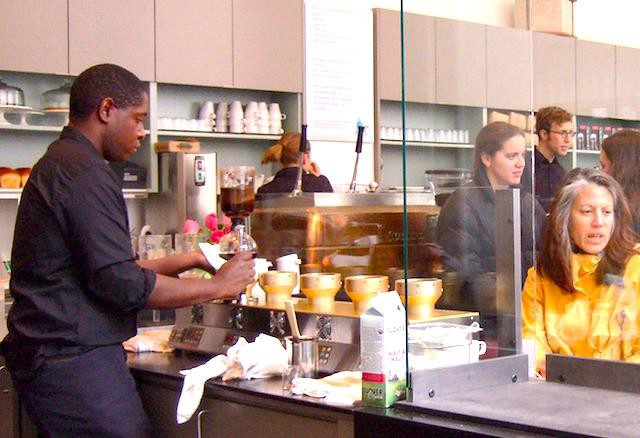
When I first moved to New York I worked, for six months or so, at a struggling cafe on 8th street in the West Village. My manager, who’d come to the States from Korea as a boy, wore expensive cufflinks and chased beautiful women through the West Village’s wine bars at night; slick and attractive, just the right side of oily, he’d been hired by the (also Korean) owners to bring some young-and-cool to their entrepreneurial side project. On that barren stretch of 8th street I served waffles piled high with whipped cream and peanut butter to red-eyed, damp-looking college freshmen. And as in many of the Village’s establishments, our regulars were the products of a smoking-permitted, rent-controlled New York; slim older men with charming alcohol problems came in during the evening and wound tales about suicidal girlfriends, going Downtown, the time they met — or truthfully, almost met — Jimi.
But the cafe shuttered. It was too eclectic to be considered a high-end coffee place, not opulent-looking enough to join the waves of below-ground wine bars. On that terrible and anonymous stretch of 8th street, still surrounded by combination tattoo parlor-head shops, it didn’t stand a chance.
I moved to Greenpoint, in 2010, and began looking there. As any barista will tell you, switching coffee shops isn’t hard. The job really only involves somewhere between six and eight discrete physical motions. You grab the white paper cups from the stack, you jam mounds of dusty ground espresso into the portafilter. If it’s within your purview, you slide exactly 3.5 feet northwest to reach the cash register. Learning a new job is simply a matter of reorienting your muscle memory to recognize a different set of tools; the bagel-slicing knives may be lighter, the ceramic mugs a little farther to the left. Professional development is really about figuring out how to perform these six-to-eight movements at an ever-increasing pace, perhaps with some degree of style. Flipping cups idly in midair is a bonus, as is being able to move seamlessly through moves 1, 4, 6, 2, and then 4 again while performing whatever conversational acrobatics a customer may implicitly demand.
After a while, the process of dealing with the clientele itself can conform to a similar — albeit slightly more nuanced — math. Somewhere around the hundredth order, the expectations underneath each inflection become easier to decode, like you’ve developed a sixth sense. Often it was simply detecting how much overt power a customer wished to exercise. By far the simplest to please are, unfortunately, the most cliche: the older, better-dressed, and very likely monied ones. They want substitutions and customized drinks, and from their servers, only hyper-polite deference. For a woman, men over a certain age are easy, most of the time — there is but only one marginally flirtatious smile, and all it requires is a twist of the mouth.
To fill the time between taking a customer’s order and ringing them up, a few stock questions can be used interchangeably, depending on the time of day and how expectantly or boredly the person in question is gazing across the counter, in your general direction. If it’s a Monday morning: “Going to work?” On a Thursday: “Plans for the weekend?” On a Saturday, during the brunch rush: “Have a good night last night?” And, in case you’re too exhausted to remember the more timely openings: “So how you doin’ today?”
It’s not that I didn’t care about certain customer’s responses, or genuinely enjoy the answers on occasion. In Brooklyn, one stout, bearded regular had a particularly self-effacing way about him — every weekday morning, he’d arrive with his messenger bag slung around his shoulders and sit in the back, eating granola and drinking an americano before he rode his bicycle up through Queens and into Midtown. He worked in advertising, I think, “something horrible and old,” he told me. I’d poke fun at him sometimes, asking if he was reading The Believer on his iPhone, if LCD Soundsystem was playing on those earbuds. “No,” he scowled, head bent down in mock shame. “I’m listening to podcasts.”
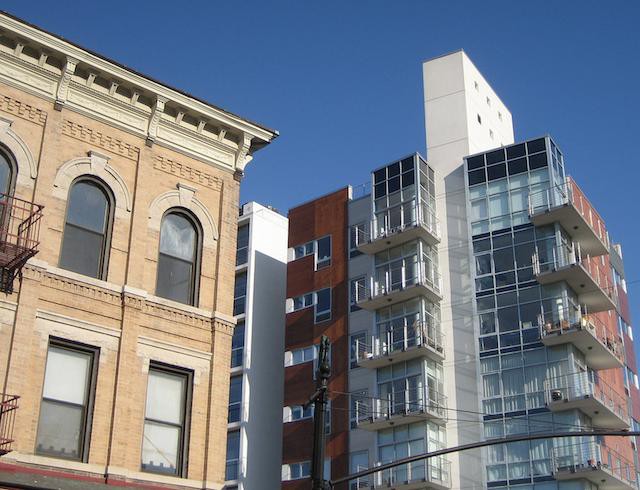
Take what you will from his irony, but laughing about all of our posturing relieved some of the tension of performing in earnest. That guy was certainly easier to serve than the aspiring filmmaker who, no matter how long the line was, would park in front of the espresso machine and unleash a running commentary on the current state of independent cinema. As it turned out, when I started working in Brooklyn, the most difficult to serve were the ones who wanted — or expected, really — for you to be cool, or at least receptive to a certain projection of hip-and-coolness. It was nice, at first, to have a job that let me swear and show my tattoos, but the pleasure of that freedom waned somewhat when most of my interactions became about the “fucks” and body modifications. If I had a quarter for every time I showed off my expensive liberal arts degree, holding up my end of a conversation about New York’s small presses or the most recent issue of The New Yorker, my tips certainly would have been better.
I once had a friend who quit his job as a bike messenger because, as he told it, people on the street started to resemble nothing more than obstacles in the way of his next commission. If delivery work makes all humans into roadblocks, front-of-the-house service professions render them as a collection of preferences and tastes and, as both Pierre Bourdieu and latte orders have taught me, taste is almost never singular. Luckily there really aren’t that many kinds of people buying $5 coffees in Brooklyn, and thus there are a limited number of ways in which it becomes necessary to communicate, particularly once you figure out which parts of yourself are most in demand.
When I applied for the coffee shop job in Greenpoint that I hoped would be my last, I was given an application to fill out. I wore a dress to the interview, but the manager who interviewed me sat across the table in cut-off shorts.
The shop had been built three years prior on the ground floor of an apartment building near the far edge of a neighborhood just beginning to grow some expensive rents. The storefront was little more than a hallway with a long service counter and a few tables, but there was a bench out front on which one could smoke a cigarette and gaze out onto the block, a residential valley boxed in by warehouses on three sides. The owner herself was a commanding and, as it turned out, deeply loyal woman who’d built herself into the business. She’d started out young as the star manager of a few well-known coffee joints on the other coast, right around the time slow-roasted cafe culture began migrating across the country. The sound system alternated between difficult, brainy rock music and indie classics. We sold, with great pride, only espresso drinks — no drip coffee. Several of the employees, in their late twenties and sometimes early thirties, lived in the area and had worked there for years. It was, as everyone would tell me, a “neighborhood place.”
The information on the application they gave me had little to do, on the surface of things, with the skills I’d be using behind the counter. I listed my five favorite bands and what I liked to read. I circled what I hoped were the appropriate answers to a series of multiple-choice questions: croissants or baguettes? Chelsea or the LES? New York Magazine or The New Yorker? It was the first indication that perhaps I had other, more latent qualities that were just as monetizable as my ability to pour milk in the shape of a heart.
I must have answered correctly, somehow — I’d stay behind the imitation-vintage espresso machine in that tiny blue storefront for the next four years, through my attendance at a mid-level liberal arts college and for two years after my graduation. I started at eight dollars an hour, plus tips, and received one raise in my time behind the counter; it almost goes without saying, but the only benefits I received were free sandwiches. At the most, I managed 28 hours a week at the shop — adjusting for the tip rate’s seasonal changes, I estimated I made a little under $18,000 a year.
Most days, when I was working, I’d rise at 5:30 a.m. to be at work at 6. There was something pleasant, almost pastoral about those mornings: unlocking the shop, listening to the hum of the machine as it warmed up, letting the baker in to deliver fresh baguettes. My customers, especially in the early days, were almost exclusively people who lived on the up-and-coming blocks surrounding the shop, or worked in the warehouse-turned-open offices at the end of the street. There really weren’t that many of them. They were location scouts, writers, web developers. Some were bartenders at the kinds of places I fancied myself too mangy-looking to work in. A few had been there so long they reminisced about bare-knuckle boxing matches in the empty lot across the way.
The northernmost edge of Greenpoint is so mixed-use as to confuse the raze-and-rebuild model as executed in Williamsburg. Blocks from the noxious Newtown Creek and the Pulaski Bridge into Queens, it’s just outside of the area touched by an infamous oil spill, yet still close enough to the neighborhood’s massive — and still functional — industrial area to feel barren. This part of Greenpoint is ill-served by the subway and contains at least two halfway houses alongside the retrofitted warehouses housing high-end print shops and welding facilities. And where most of Greenpoint is overwhelmingly Polish, that block lit up at night with Spanish-speaking residents hunched over sidewalk card tables blasting salsa and meringue from their cars.
The neighborhood was changing fast. Being a barista in North Brooklyn was wildly different than in any other coffee shop I’d worked. It might have been that I held that job for the longest, or that other blocks on which I’d worked previously weren’t sprouting high-rise condos at such an alarming pace. But thanks, in part, to the narrowness of the wood-paneled, low-lit aesthetic logic of the creative class, it wasn’t just a coffee shop I was staffing, but a gentrification.
To staff a demographic shift as massive as the one that’s taken place around Williamsburg and Greenpoint requires quite a bit of manpower. More than 130 new buildings went up in the space of just a few years; rents rose almost 175% in under than a decade; also, the “Hipster Olympics” was born. We have rockabilly vegan diners and bars that dole out free pizza; nautically-themed coffee shops and Italian-themed coffee shops and the coffee shop where Hannah worked in “Girls.”
The transition is that the neighborhood is known better for its production of capital-e Experiences than salable goods. These experiences feed new residents’ hunger for “third place” interactions, as well as a growing tourism industry. Brooklyn’s CB1, the community board responsible for Greenpoint and Williamsburg, was so shocked by the density of bars cropping up in the neighborhood circa 2009 that they attempted to put a moratorium on new liquor licenses, until enterprising business owners (and the New York State Liquor Authority) intervened. A survey of Yelp counts 36 coffee shop and cafes in Greenpoint, a neighborhood spanning 1.2 miles and largely zoned for residential and industrial use.
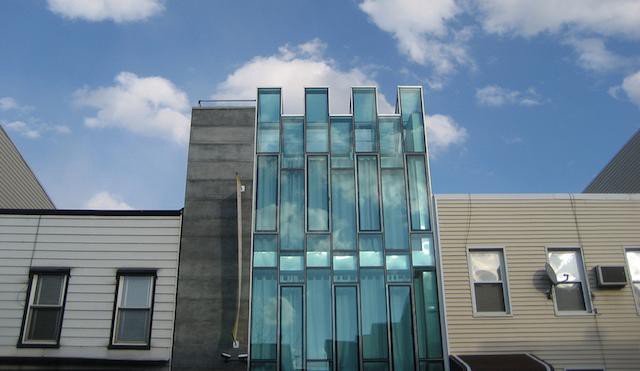
The national unemployment rate was hovering close to ten percent while I was in school, and if I ever doubted how lucky I was, I had only to look around my own place of employment. The shop was perpetually full of people glaring at their laptops. Some endlessly scrolled through the universal yet private hell of Craigslist job postings. Others hammered away manically, picking away at their corner of the gig economy, that handily shortened name for what had once been termed the Industrial Revolution of our time. It had been estimated, around 2010, that there were a million freelancers in New York. I only knew one or two who were making it work — for everyone else, working for yourself just meant begging for projects while you looked for a job. I was lucky.
As of 2012, one in ten employed Americans worked in food service. Two-thirds of them are under 35. The average hourly wage for a food service worker, according to the Department of Labor, is around $12, with a work week less than 25 hours long. It comes out to a little more than $14,000 a year. These are jobs without benefits or much potential for upward mobility, jobs where the idea of a sick day is laughable. Almost 60% of new jobs are of the low-wage, high-turnover variety; food service ranks in the top five of industries with job growth; the others are mostly in healthcare.
But service work is not one kind of work; it would be foolish to lump all service professions into the same category. There’s also nothing inherently wrong with this kind of labor. The job I held as a barista was a very good one by many counts, close to or even in the upper echelon as far as service work goes — particularly if you were married to someone with insurance, or using the shop’s sound system to promote your band, as many did. I hauled in decent tips, listened to the music I wanted to hear, fueled my americano habit for free, and suffered what felt like outright abuse very rarely. There’s something to be said for a job that not only allows, but by virtue of its culture practically encourages, behavior that would be unacceptable elsewhere. Baristas of this Richard Floridian “street-level” variety are expected to assholes: we are perpetually hungover; we really don’t like tourists. Our problems, if they can be called that, are of being hyper-visible in an industry full of the invisible.
My kind of service work is not the kind of service work that puts you in the back room washing dishes for 12-hour shifts for dollars because you are considered completely expendable. But my kind of service work is part of the same logic that indiscriminately razes neighborhoods. It outsources the emotional and practical needs of the oft-fetishized, urban-renewing “creative” workforce to a downwardly mobile middle class, reducing workers’ personality traits and educations to a series of plot points intended to telegraph a zombified bohemianism for the benefit of the rich.
Three or four years ago, our glass storefront was the only business in our section of Greenpoint that catered to the soymilk and Sonic Youth crowd. There was a hardware store and the requisite dive bar — and those halfway houses. The city added another 200-bed homeless shelter just one street over a few years later. After locking the door at night, I’d sometimes ask one of my roommates to walk me back home; guys were known to come in later in the evening and pry their cock out of their pants, or shoot up in the bathroom and leave their needles on the white-tiled floor. Now there’s a more spacious cafe next door, a black metal bar down the street, a yoga studio, a grocery selling imported beer and cheese a block away. I know all the owners quite well — they were, largely, the frontiersmen. They were the people who had been coming to the coffee shop since before the condo construction began in earnest, when it was opened to serve the neighborhood not exactly as it was, but as it would someday be.
While the framing of the third place may have been useful for Starbucks’ promotional materials, Oldenburg’s theory really didn’t account for the realities of capitalism: that private business creates narrow spaces. Grabbing a croissant and an americano every morning from the same group of downwardly mobile performer-bohemians is the perfect test case for the creative class’s ideal of semi-anonymous community. After a while working these jobs, answering the same class-baiting questions day after day, it starts to feel more like playing a set piece than anything else.
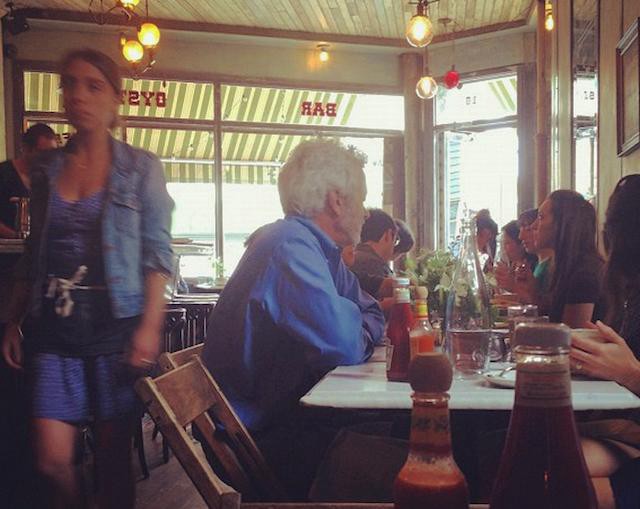
You can always tell when a customer is the kind who really Likes to Know His Service People. When he’s new to the neighborhood he’ll stroll in and start asking questions; about your favorite bar, your tattoo, what’s playing on the sound system. In an uncomplicated set of cultural cues — calling people of both genders “man,” reminding you about his DJ set at such and such bar down the road, reminiscing about that great cup of joe he once drank in Seattle — he’ll mark himself as totally down, a member of the just-recently-completely-bohemian creative class. He tips well, which is a plus, but you probably lose that money in time when he parks himself in front of the counter and stalls the line. He’s complimentary in a way that probably isn’t meant to be condescending about how totally awesome it is, the way you spread the cream cheese on his bagel just so.
In Brooklyn, as you order your home-grown-arugula and lemon pizza, your server can entertain you with their opinions on Jonathan Franzen, their fluency in Swedish design concepts. Tipping them is kind of like supporting the arts. Somewhere, I imagine, there really is a place where the server and the served interact on equal footing, reciprocally enjoying a shared culture. Perhaps it’s simply an issue of remuneration. Maybe that place is in Portland, where rents are cheaper and the rich aren’t as, well, filthily so.
I watched my co-workers strike out to take internships, get associate’s degrees, start their own businesses. Six months, a year would go by and they’d return to the shop, or appear suddenly behind the bar a few blocks away. They’d trade positions, moving laterally instead of upward, taking a job at the new coffee shop when they were offered a more forgiving schedule, trading the nautically themed bar for the rockabilly cafe in exchange for better tips. “Lifer” is a strong word, but it doesn’t feel entirely inappropriate. It’s been a while since I quit my barista gig, but when I go out in my neighborhood, drunk undergraduates still shout their regular coffee orders at me.
For years I worked with a guy I’ll call Tom. He was a gentle 32-year-old touring musician with an oddly professorial look for someone with a ponytail and perpetually ripped t-shirts. In the fulfillment of his lifelong dream, he’d opened a recording studio a few blocks from the coffee shop where we worked, an endeavor that landed him, as far as I could tell, deeply in debt. He worked mornings at the coffee shop and booked recording sessions late into the night, moving into the studio with its mini-fridge and shag rug when he couldn’t afford his apartment anymore. I was pretty sure he lived exclusively on the bagels he’d come by the shop on a nightly basis to collect. For all of North Brooklyn’s book groups and websites and meet-ups dedicated to alternative monetary systems, the solidarity economy is, for the time being, at its best in the service sector. I can barely remember paying full price for anything. Checks for Negronis, artisanal spicy pickles, hand-roasted coffee beans, and sometimes entire locally sourced meals disappeared with a wink and a nudge reminiscent of Fight Club’s ominous waiter scene. At the very least, it allowed us to participate in a culture we couldn’t really afford. At its vilest it felt like a neighborhood of people working for slightly more than minimum wage in exchange for a chance to play-act at brunching in a nice neighborhood.
Rarely spoken aloud, the tendency of Greenpoint’s service class to take care of its own was one of the only outright gestures of solidarity I witnessed, the only place where a distinction was made between the server and the served. I suspect the rarity of that admission has something to do with the fact that, for most intents and purposes, our jobs relied on completely erasing that distinction from public view.
Serving can be deeply satisfying work, physically and emotionally; I’ve rarely felt more in my body than on those days when I got the math right, pulled the lever down on the espresso machine as I reached for the next cup, knocked out ninety drinks in an hour. But service isn’t considered lesser than other professions because it’s less honorable, or even requires fewer skills. I’d love to see a graphic designer take apart each component of an ancient espresso machine for which no manual exists, or watch a fact-checker talk a junkie out of a bathroom without getting the police involved. The knowledge required to read a customer, to justify the processes and origins of that $12 cup of coffee, is just as specialized as knowing what a nut graph is. And, to be perfectly real, this is New York, and America, and the world; just a couple steps up the food chain, we’re all serving someone.
These jobs are seen as lesser because we made them this way. We built our brave new urban economy on an ever-specializing transient workforce, an army of lifestyle brand ambassadors without the business cards or the 401(k). Best of luck being a good enough bartender to get some health insurance out of the deal, or even enough hours on the clock to make rent. Who knows what happens after 40, if you haven’t managed to open your own little street-level franchise amidst the undiscovered ruins of yet another post-industrial district.
The practice of exploiting a vulnerable service class to build a playground for the wealthy by no means started with college graduates in Brooklyn. This is but one hyper-specific strain of the thing, mutated to appease a population whose primary demands include Kurosawa references and intelligent conversation at brunch. But there is an overarching logic, and it shouldn’t be rendered invisible.
One might think in neighborhoods that have long given up the production of goods in favor of the provision of services, some adjustments should be in order. But with no cohesive labor movement and a roaring demand for more services — and experiences — wherever the wealthy choose to migrate, it doesn’t look as if the industry will change significantly anytime soon, even as hospitality becomes the functional backbone of American job growth.
When I did finally try to quit being a barista, it took about a year to make the transition into something else. The stratification starts early; once this is your resume, you don’t get many chances to revise it. It was only because of a death in the family and some unexpected cash that I was able to take an internship — a paid one! Thanks, Ross Perlin — and endure the requisite uncertainty taking temporary work entails. I have no illusions that my jump into the creative class was anything but pure, unearned luck.
At one point in what felt like an endless job search, I walked into an editor’s office to find, to my absolute horror, that I’d served him coffee for years. Nervously I answered his barrage of questions about my background and qualifications. Right before the interview ended he made the connection (“I knew you looked familiar”) and complimented me on my superior espresso skills. I thanked him.
As I walked out of the glass-walled office and into the massive open-layout loft, full of the hip-and-cool and their glowing laptops, the editor turned to me and asked me if I really, you know, wanted to do the job I’d applied for. “I would feel bad taking you away from them,” he said. “You know, you’re, like, really good at making coffee.”
Molly is an editor at Cluster Mag
. She still makes a killer cup of coffee.
Top photo by Matt Biddulph. Pourover photo by “John.” Blue Bottle barista photo by Sean Savage. Greenpoint old and new by “Zach.” Gentrification photo also by “Zach.” North Brooklyn brunch waitron photo by “special operations.”
